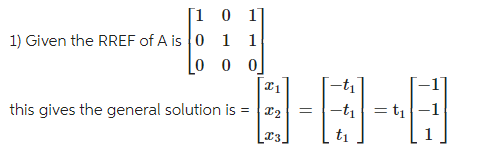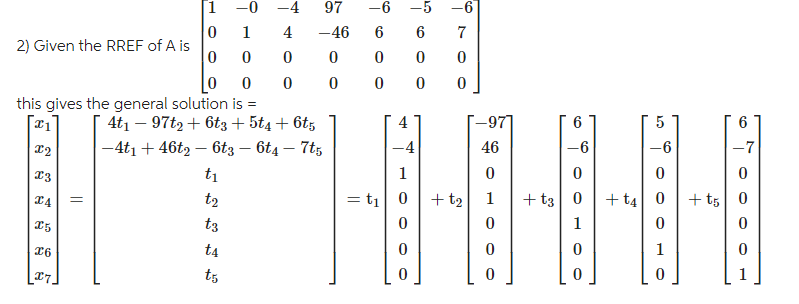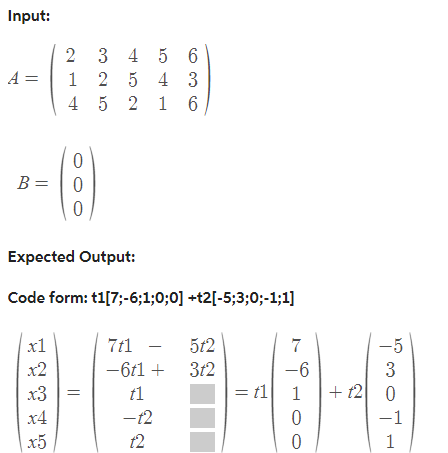Question
The code below is designed to take in an Augmented matrix (Concatenating A and B) and produce the linear combination of the system in terms
The code below is designed to take in an Augmented matrix (Concatenating A and B) and produce the linear combination of the system in terms of the free variables. The free variables will be given the variables t1, t2, ..., tn for the nth free variable. However, the code is not working properly. The code needs to be fixed so that it matches the input of the expected outputs below. The code should be able to output the linear combination of the system in terms of the free variables regardless of the size of the matrix, for example, a 1 x 10, 5 x 5, or 7 x 3. Look at the 4 test cases below and make sure that the coed could output the linear combination as a whole with its column matrices and free variables.
Code:
A = [2 3 4 5 6; 1 2 5 4 3; 4 5 2 1 6];
B = [0; 0; 0];
Aug = [A, B]
[basic_cols, non_basic_cols, num_basic, num_non_basic] = augmented_rref(Aug);
function [basic_cols, non_basic_cols, num_basic, num_non_basic] = augmented_rref(Aug)
% Function to find the basic and non-basic columns of an augmented matrix
% Input: Augmented matrix, with last column as B from the left side
% Output: Basic and non-basic columns in short and long form, and their counts
[m, n] = size(Aug);
RREF = rref(Aug);
pivots = [];
% Finding pivot columns
for i = 1:m
for j = 1:n
if RREF(i,j) == 1 && ~ismember(j, pivots)
pivots = [pivots, j];
break
end
end
end
basic_cols = cell(1, length(pivots));
non_basic_cols = cell(1, n-length(pivots));
num_basic = length(pivots);
num_non_basic = n-length(pivots);
% Separating basic and non-basic columns
for i = 1:n
if ismember(i, pivots)
basic_cols{i} = ['X', num2str(i)];
else
non_basic_cols{i-length(pivots)} = ['X', num2str(i)];
end
end
% Finding the solution in terms of free variables
solution = zeros(n-1,1);
free_cols = setdiff(1:n-1,pivots);
if ~isempty(free_cols)
for i = free_cols
solution(i) = 0;
for j = pivots
if RREF(find(pivots==j),i) ~= 0
solution(i) = solution(i) - RREF(find(pivots==j),i) * solution(j);
end
end
solution(i) = solution(i) + RREF(end,i);
end
end
% Printing the solution in printable form
solution_str = [];
for i = 1:length(free_cols)
solution_str = [solution_str, 't', num2str(i), '['];
for j = 1:n-1
if ismember(j,pivots)
solution_str = [solution_str, num2str(RREF(find(pivots==j),free_cols(i))), ';'];
elseif j == n-1
solution_str = [solution_str, num2str(RREF(end,free_cols(i))), ']'];
else
solution_str = [solution_str, '0;'];
end
end
if i ~= length(free_cols)
solution_str = [solution_str, ' + '];
end
end
solution = solution_str;
disp(['Solutions: ', mat2str(solution_str)]);
% Outputting results
disp(['Augmented Matrix: ', mat2str(Aug)]);
disp(['RREF: ', mat2str(RREF)]);
disp(['Basic Columns: ', mat2str(Aug(:, pivots))]);
disp('Short Form:');
disp(['Basic Columns: {', strjoin(basic_cols(~cellfun('isempty',basic_cols)), ', '), '}']);
disp(['Non-Basic Columns: {', strjoin(non_basic_cols(~cellfun('isempty',non_basic_cols)), ', '), '}']);
disp('Long Form:');
disp(['Basic Columns: ', mat2str(Aug(:, pivots))]);
disp(['Non-Basic Columns: ', mat2str(Aug(:, setdiff(1:n, pivots)))]);
disp(['Number of Basic Columns: ', num2str(num_basic)]);
disp(['Number of Non-Basic Columns: ', num2str(num_non_basic)]);
end
Test Cases
1) Input:
A = [4 8; 1 7; 2 4]
B = [12;8;6]
Output:

 \
\
2)
Input:

Code form:
A = [2 3 4 56 6 8;1 2 4 5 6 7;3 6 12 15 18 21;4 6 8 112 12 16]
B = [9;8;24;18]
Output:

3)
Inputs

Code form:
A = [3 4 5;1.5 2 2.5]
B = [1;0.5]

4)

4128741286 1) Given the RREF of A is 100010110 this gives the general solution is =x1x2x3=t1t1t1=t1111 213432664412856515112661812872116982418 2) Given the RREF of A is 100001004400974600660056006700 this gives the general solution is = x1x2x3x4x5x6x7=4t197t2+6t3+5t4+6t54t1+46t26t36t47t5t1t2t3t4t5=t14410000+t2974601000+t36600100+t45600010+t56700001 (31.54252.5121) 3)Given the RREF of A is : [10340350310] this gives the general solution is =34t135t231t3t1t2t3=t134100+t235010+t331001 Input: AB=214325452541636=000 Expected Output: Code form: t1[7;-6;1;0;0] +t2[-5;3;0;-1;1] x1x2x3x4x5=7t16t1+t1t2t25t23t2=t176100+t253011
Step by Step Solution
There are 3 Steps involved in it
Step: 1

Get Instant Access to Expert-Tailored Solutions
See step-by-step solutions with expert insights and AI powered tools for academic success
Step: 2

Step: 3

Ace Your Homework with AI
Get the answers you need in no time with our AI-driven, step-by-step assistance
Get Started


